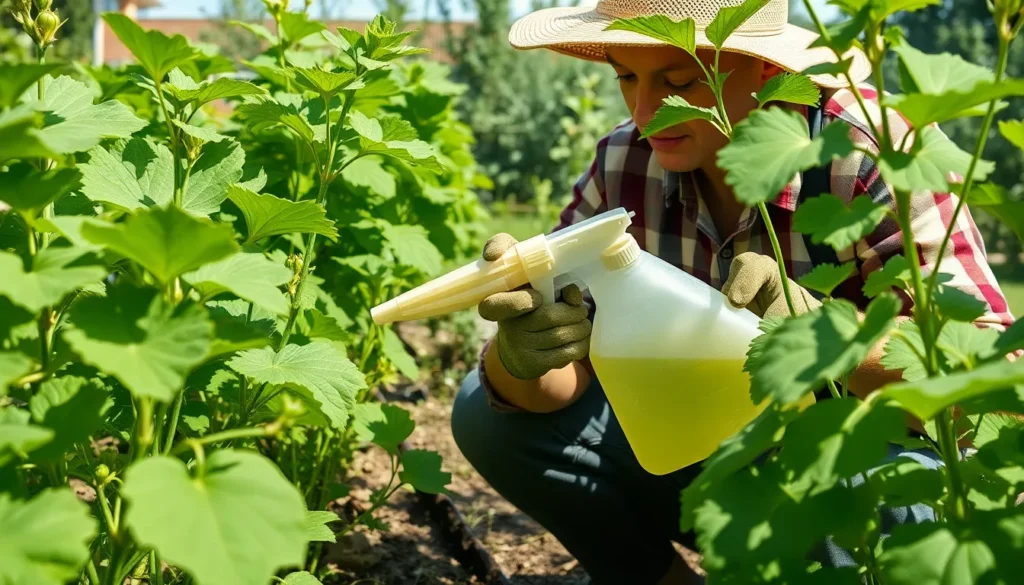We’ve all been there – walking through our garden only to discover tiny green or black insects clustering on our favorite plants. These pesky aphids can quickly turn a thriving garden into a stressed-out mess, sucking the life from leaves and stems while multiplying at an alarming rate.
The good news? We don’t have to surrender our plants to these unwelcome visitors. With the right knowledge and techniques, we can eliminate aphids effectively while keeping our gardens healthy and chemical-free. Whether you’re dealing with a minor infestation or a full-blown aphid invasion, there are proven methods that work.
From simple household remedies to natural predator answers, we’ll show you exactly how to reclaim your garden from these destructive pests. Let’s jump into the most effective strategies that’ll have your plants aphid-free and flourishing once again.
Identify the Signs of Aphid Infestation on Your Plants
Before we can eliminate aphids from our gardens, we need to recognize the telltale signs of their presence. Early detection makes treatment more effective and prevents widespread damage to our plants.
Look for Visible Aphids on Stems and Leaves
Aphids cluster in colonies on soft plant tissues, making them relatively easy to spot during regular garden inspections. We’ll find these tiny insects congregating on new growth, flower buds, and the undersides of leaves where the plant tissue is most tender.
Green aphids blend with foliage but become visible when we examine plants closely, especially during morning hours when they’re most active. Black, brown, or red aphids stand out more prominently against green leaves and stems.
Size varies from 1 to 4 millimeters, with most species appearing as small, soft-bodied insects that move slowly across plant surfaces. We can identify them by their pear-shaped bodies and long antennae that extend from their heads.
Winged and wingless forms occur within the same colony, with winged aphids typically appearing when populations become overcrowded and need to spread to new host plants.
Check for Honeydew Residue and Sticky Surfaces
Honeydew appears as a clear, sticky substance coating leaves, stems, and surfaces beneath infected plants. This sugary secretion results from aphids feeding on plant sap and excreting excess sugars they cannot process.
Sticky droplets accumulate on plant surfaces and attract ants, which feed on the honeydew and often protect aphid colonies in return. We’ll notice ants marching up and down plant stems as they tend to their aphid “livestock.”
Sooty mold develops on honeydew deposits, creating black, powdery patches that reduce the plant’s ability to photosynthesize effectively. This secondary fungal infection indicates a well-established aphid problem that requires immediate attention.
Garden furniture and walkways beneath infected plants become sticky and may develop the same sooty mold growth, helping us identify problem areas even from a distance.
Notice Yellowing or Curling Plant Leaves
Yellowing leaves indicate nutrient depletion caused by aphids draining essential plant fluids during their feeding process. We’ll observe this discoloration starting with older, lower leaves before progressing upward through the plant.
Leaf curling occurs when aphids inject saliva into plant tissues while feeding, causing cellular damage that distorts normal leaf development. New growth appears twisted, puckered, or cupped as it emerges.
Stunted growth becomes apparent in heavily infested plants as aphids weaken the plant’s overall vigor and ability to develop normally. We’ll notice reduced flowering, smaller fruit production, and delayed maturation in affected crops.
Wilting symptoms may develop even though adequate soil moisture, as damaged vascular tissues struggle to transport water and nutrients throughout the plant effectively.
Remove Aphids Using Natural Water Methods
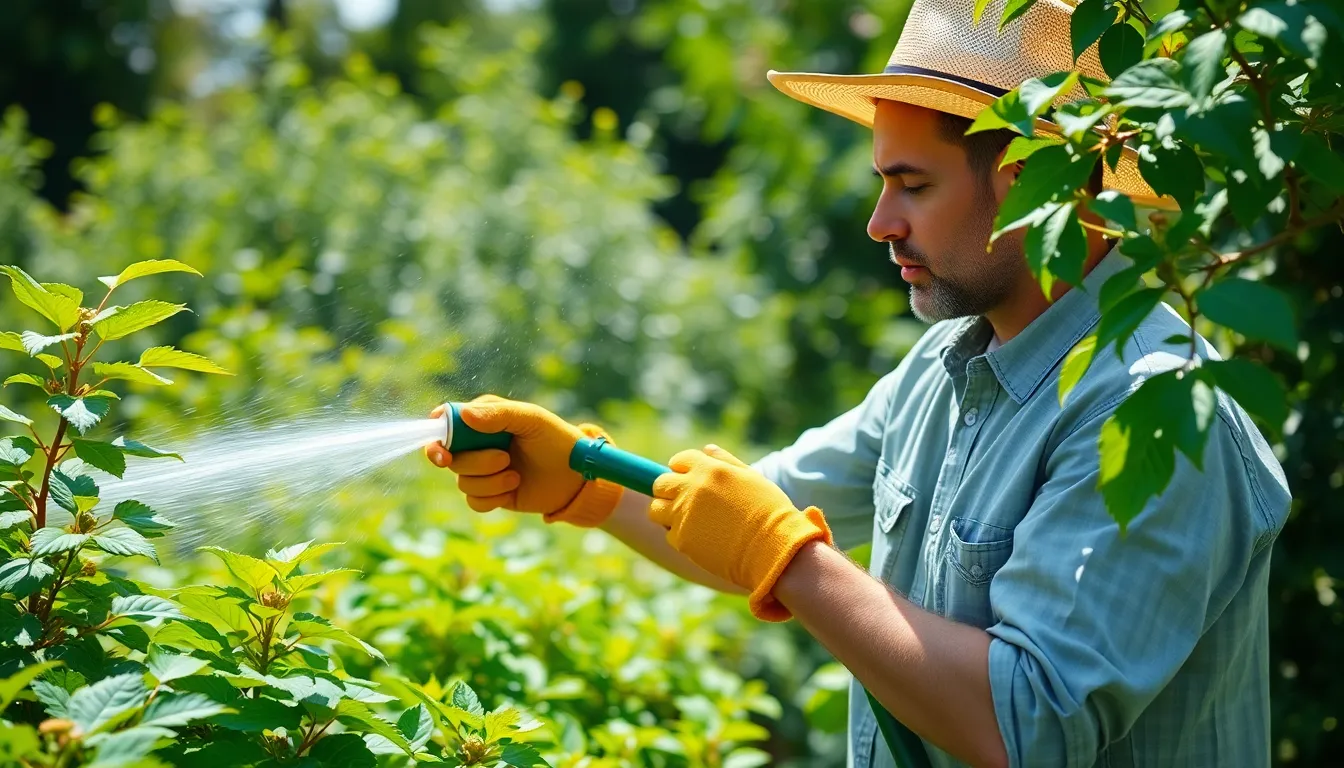
Now that we’ve identified aphid infestations, we can tackle them using simple water-based techniques that effectively eliminate these pests without harmful chemicals.
Spray Plants with a Strong Garden Hose
Direct a strong stream of water from your garden hose to physically knock aphids off your plants. This method works exceptionally well early in the season before infestations become severe. We recommend focusing the water pressure on the undersides of leaves where aphids typically cluster and feed.
Adjust the water pressure carefully to avoid damaging delicate plants. Young seedlings and fragile flowers require gentler pressure than established shrubs or trees. Repeat this treatment every few days until you notice the aphid population decreasing significantly.
Target exact areas where aphids congregate most heavily. New growth tips, flower buds, and tender stems often harbor the largest colonies. The force of the water disrupts their feeding and makes it difficult for them to reestablish on the same plant.
Apply Soapy Water Solution to Affected Areas
Mix a few drops of dish soap with water in a spray bottle to create an effective aphid treatment. We prefer using mild dishwashing liquid rather than harsh detergents that might damage plant tissues. The soapy solution suffocates aphids and disrupts their ability to feed on plant juices.
Spray the solution liberally on all plant parts, paying special attention to leaf undersides. Complete coverage ensures that hidden aphids don’t escape treatment and continue reproducing. The soap creates a film that traps aphids and prevents them from moving to new feeding locations.
Apply the treatment during cooler parts of the day to prevent leaf burn. Early morning or evening applications work best since intense sunlight can cause the soap solution to damage leaves. Reapply every few days until the aphid population disappears completely.
Use a Wet Cloth for Small Infestations
Wipe affected plant areas with a damp cloth to physically remove aphids from minor infestations. This hands-on approach works particularly well for houseplants or small garden sections where precision matters most. We recommend wearing rubber gloves to protect your hands during the process.
Pick individual aphids off by hand and drop them into a container of soapy water. This method ensures complete removal and immediate elimination of the pests. Focus on visible clusters first, then examine the plant thoroughly for any remaining individuals.
Remove heavily infested leaves and aphid eggs during your cleaning process. Pruning damaged foliage breaks the aphid life cycle and prevents future generations from establishing. Dispose of removed plant material away from your garden to prevent reinfestation.
Apply Homemade Insecticidal Soap Treatments
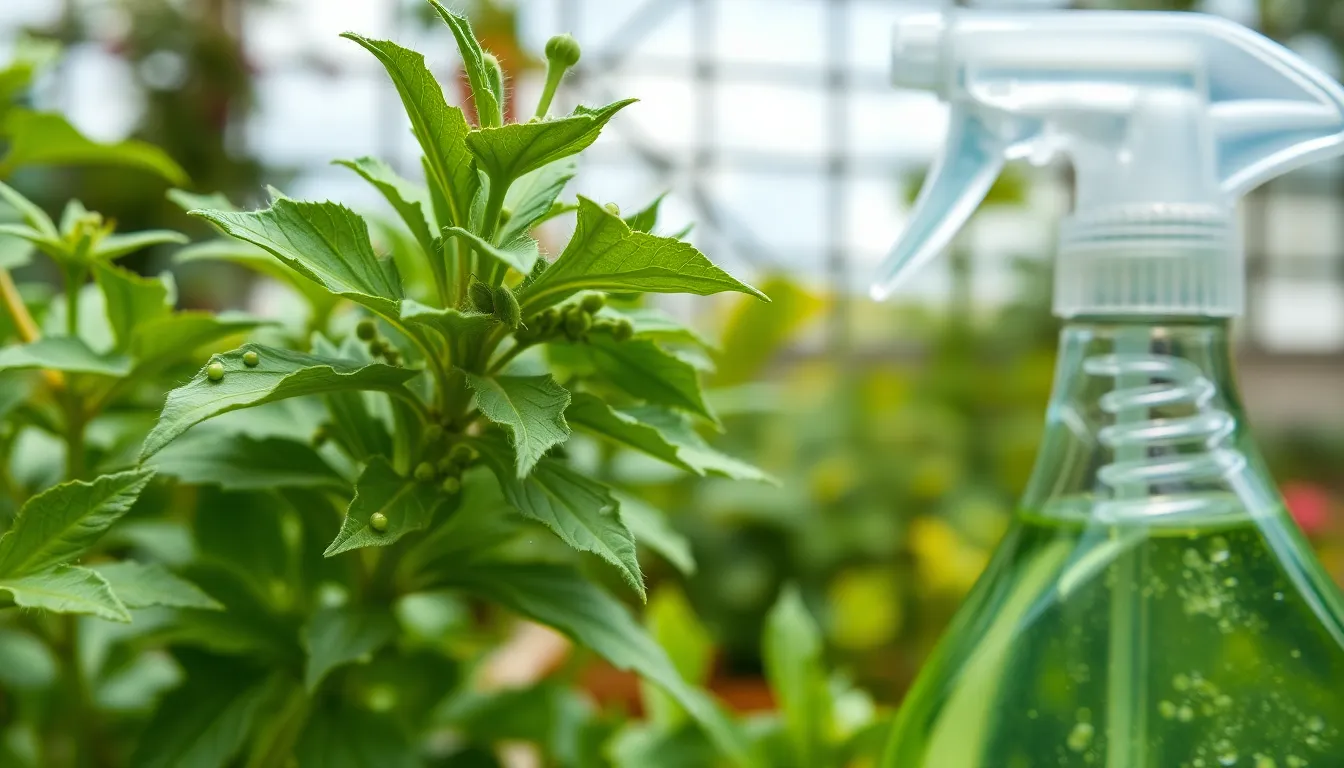
Homemade insecticidal soap answers offer one of the most effective and gentle approaches to eliminate aphids from our plants naturally.
Mix Dish Soap with Water for Gentle Control
Mix a few drops of mild dish soap in a spray bottle filled with water to create an effective aphid control solution. We recommend using gentle dish soap that doesn’t contain harsh chemicals or fragrances to avoid damaging plant tissues. The soap works by breaking down the protective outer layer of aphids, causing dehydration and death within hours of application.
Apply this soapy water mixture directly onto visible aphid colonies, ensuring complete coverage of affected areas. Focus our spraying efforts on the undersides of leaves where aphids typically cluster in large numbers. This method proves particularly gentle on plant tissues while remaining safe for the environment when used properly.
Create Castile Soap Spray for Organic Gardens
Create an organic aphid treatment by mixing 1 to 2 tablespoons of liquid castile soap in a quart of water for enhanced effectiveness. Castile soap provides a plant based alternative that works exceptionally well in organic gardening systems without introducing harmful chemicals to our growing environment.
This formulation delivers stronger aphid control compared to regular dish soap while maintaining complete organic certification standards. We can apply this mixture liberally to aphid infested areas, knowing it won’t compromise our organic gardening principles or harm beneficial insects when used appropriately.
Add Essential Oils for Enhanced Effectiveness
Essential oils like neem oil, garlic extract, and onion extracts significantly boost the aphid deterrent properties of our soap based treatments. Neem oil stands out as particularly effective because it disrupts aphids’ feeding patterns and reproductive cycles, providing longer lasting control than soap alone.
Blend 1 to 2 teaspoons of neem oil or garlic extract into our existing soap spray answers for maximum impact against stubborn aphid populations. These natural additives create a powerful combination that both kills existing aphids and deters new colonies from establishing on our plants. We should apply these enhanced treatments during late evening hours to protect beneficial pollinators and maximize treatment effectiveness.
| Treatment Type | Mixing Ratio | Application Frequency | Effectiveness Duration |
|---|---|---|---|
| Basic Dish Soap | Few drops per spray bottle | Every 2-3 days | 24-48 hours |
| Castile Soap | 1-2 tablespoons per quart | Every 3-4 days | 48-72 hours |
| Enhanced with Essential Oils | 1-2 teaspoons oil per spray | Every 4-5 days | 72-96 hours |
Introduce Beneficial Insects as Natural Predators
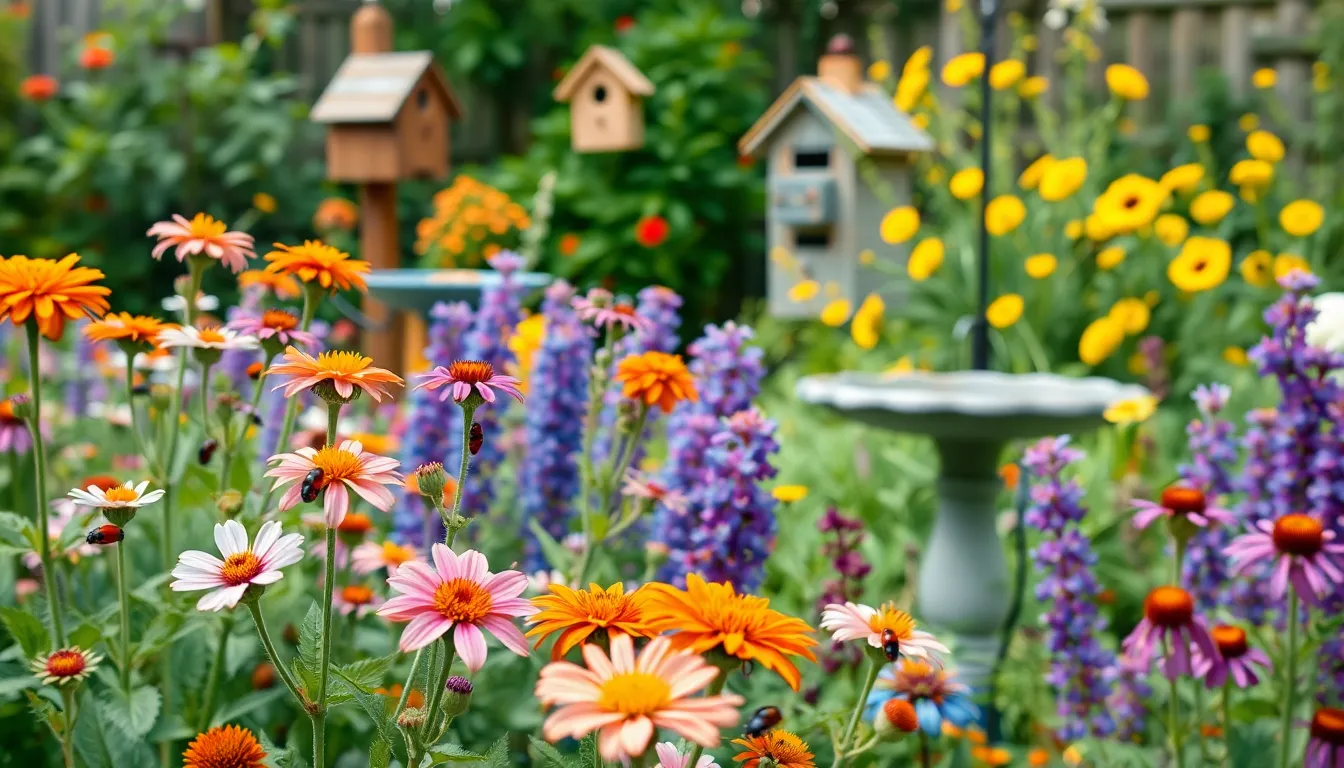
We can harness nature’s own pest control system by welcoming beneficial insects that naturally hunt and eliminate aphids. This biological approach creates a sustainable solution that works continuously without harming our plants or the environment.
Release Ladybugs to Control Aphid Populations
Ladybugs serve as voracious aphid predators that can drastically reduce aphid numbers in our gardens. These colorful beetles consume aphids during both their larval and adult stages, making them one of the most reliable natural control methods available. We can purchase ladybugs from garden centers or online suppliers and release them directly onto affected plants during cooler evening hours when they’re less likely to fly away immediately.
Adult ladybugs eat approximately 50 aphids per day, while their larvae can consume up to 400 aphids during their development period. The key to successful ladybug releases lies in timing and environment preparation. We should ensure our garden has adequate moisture and alternative food sources like pollen-producing flowers to encourage the ladybugs to establish residence rather than simply moving on to other areas.
Attract Lacewings with Flowering Plants
Lacewings target aphids through their larvae, known as “aphid lions,” which feed on large quantities of these pests. We can attract green lacewings to our gardens by planting exact flowering plants that provide the nectar and pollen adults need for survival. Dill, fennel, yarrow, clover, and mint create an irresistible buffet that draws these beneficial insects naturally.
These delicate winged insects lay their eggs on stalks near aphid colonies, ensuring their hungry larvae have immediate access to prey. We should plant lacewing-attracting flowers throughout our garden beds rather than clustering them in one area. This strategy creates multiple hunting grounds and increases the likelihood that lacewing populations will establish themselves permanently in our outdoor spaces.
Encourage Birds That Feed on Aphids
Birds serve as natural aphid controllers when we create environments that attract and support them. Many bird species including chickadees, wrens, and finches actively hunt aphids as part of their regular diet. We can encourage these feathered allies by providing fresh water sources, suitable nesting sites, and native plants that offer both shelter and additional food sources.
Offering bird feeders, bird baths, and nesting boxes transforms our gardens into welcoming habitats for aphid-eating birds. We should position these amenities near areas where aphid problems typically occur, creating a natural patrol system. Native shrubs and trees provide essential cover while also attracting insects that serve as supplementary food sources, ensuring birds remain in our gardens long enough to make a important impact on aphid populations.
Use Neem Oil as an Organic Pest Control Solution
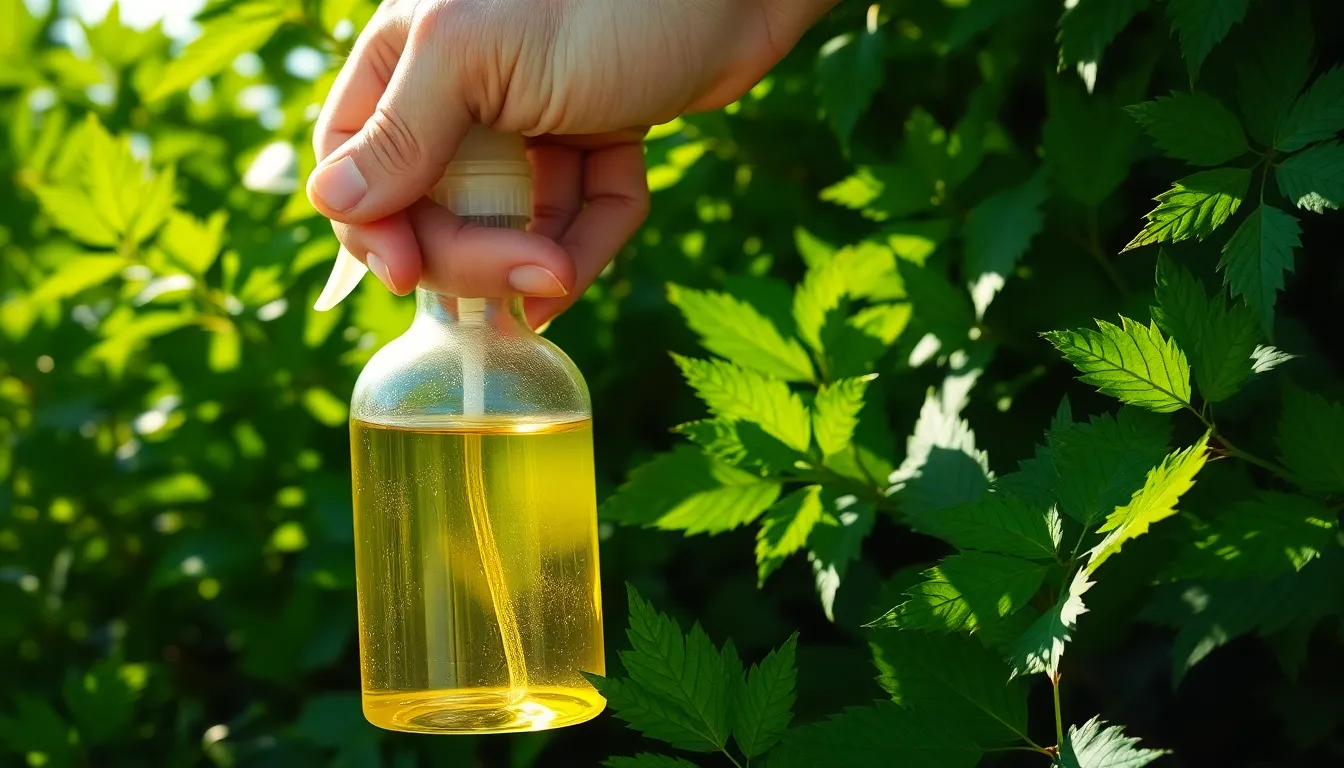
We can effectively eliminate aphids using neem oil, a natural pesticide derived from neem tree seeds that contains azadirachtin to repel and kill these harmful insects. This organic solution disrupts insect life cycles while remaining safe for humans, pets, and most beneficial wildlife.
Apply Neem Oil Spray During Cool Weather
Timing matters when we apply neem oil treatments to maximize effectiveness. We should spray our plants early in the morning or late in the evening to avoid harming beneficial insects like bees and butterflies that remain most active during daylight hours. Direct sunlight and high temperatures can damage plant foliage when combined with neem oil applications, so we avoid midday treatments entirely.
Weather conditions play a crucial role in treatment success. We wait for clear skies since rain within 24 hours will wash away our neem oil solution before it can work effectively. Cool temperatures help the oil penetrate aphid colonies more thoroughly while preventing leaf burn on sensitive plants.
Mix Neem Oil with Water and Mild Soap
Proper dilution ensures our neem oil spray works effectively without harming plants. We follow the recommended ratio listed on our product label or use commercially available neem oil sprays that come pre-mixed for convenience. Adding a few drops of mild soap or insecticidal soap helps our mixture adhere to plant surfaces and increases the solution’s effectiveness against aphids.
Preparation requires thorough mixing for consistent coverage. We shake our spray bottle well before each use since neem oil naturally separates from water over time. The soap component acts as an emulsifier, creating better contact between the oil and aphid bodies for maximum pest control results.
Repeat Applications Every Few Days
Persistence eliminates aphid infestations more effectively than single treatments. We apply neem oil spray every 3 to 7 days since this organic solution works by disrupting reproduction and feeding habits rather than providing instant kills. Multiple applications ensure we target all development stages of the aphid life cycle.
Monitoring helps us determine when to stop treatments. We continue our regular spray schedule until we observe no new aphid activity on our plants, then maintain weekly inspections to prevent re-infestation. This systematic approach balances effective pest control with environmental safety, making it ideal for organic gardening practices.
Deploy Companion Planting Strategies for Prevention
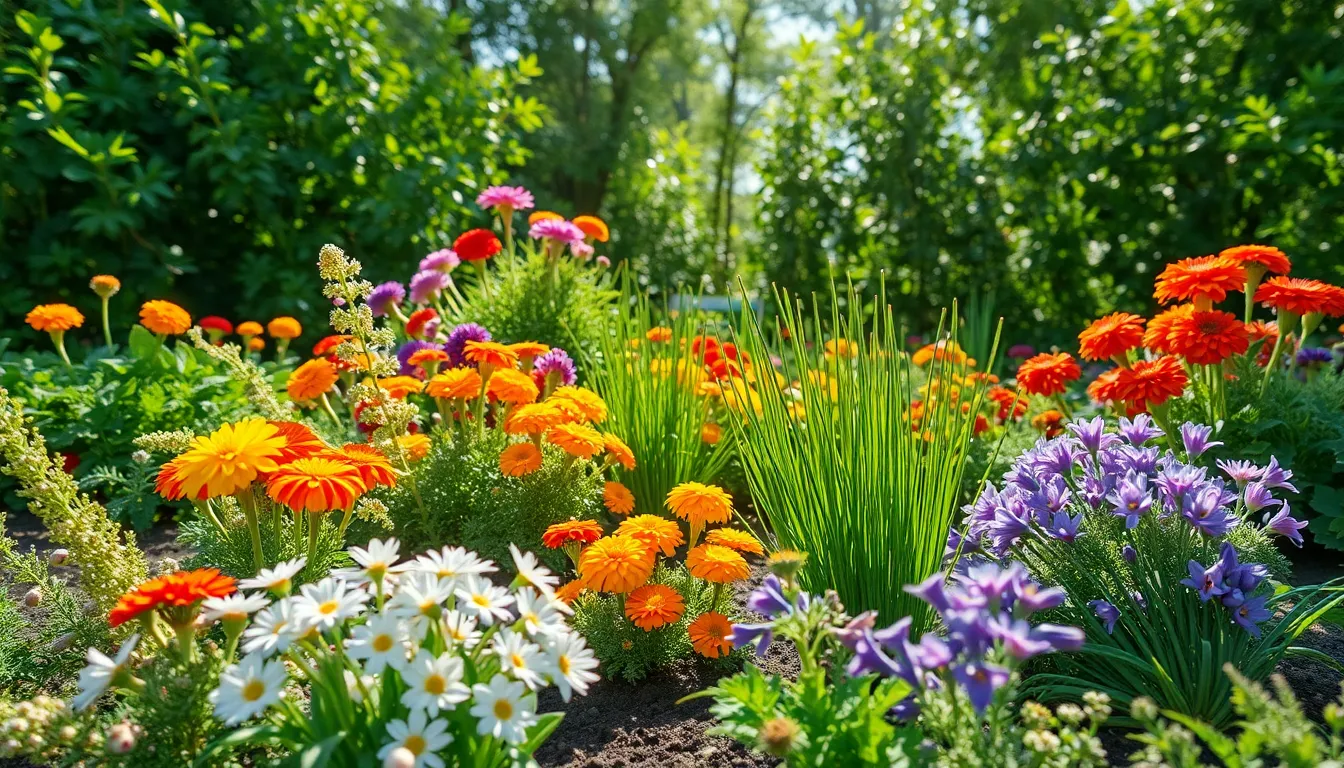
Strategic companion planting creates natural barriers that protect our gardens from aphid invasions. We can establish these protective relationships by selecting exact plants that emit scents and compounds that naturally repel these persistent pests.
Plant Catnip and Garlic as Natural Repellents
Catnip serves as one of nature’s most effective aphid deterrents due to its potent essential oils that create an unwelcome environment for these soft-bodied insects. We recommend planting catnip around the perimeter of susceptible plants like roses, peppers, and tomatoes to establish protective zones.
Garlic bulbs planted throughout our garden beds release sulfur compounds that aphids find particularly offensive. Positioning garlic cloves near vulnerable crops creates invisible barriers that discourage aphid settlement and feeding activities.
Both plants offer dual functionality since we can harvest their foliage to create homemade organic sprays that provide additional protection. Fresh garlic cloves crushed into water create concentrated repellent answers we can apply directly to affected areas.
Use Marigolds to Deter Aphid Infestations
Marigolds produce pyrethrum compounds that naturally interfere with aphid nervous systems while their pungent aroma masks the attractive scents of nearby host plants. We should plant French marigolds and African marigolds in clusters around our most vulnerable vegetables and flowers.
Strategic placement of marigolds works best when we position them as border plants or interplant them directly within our vegetable rows. Their bright orange and yellow blooms also attract beneficial insects that prey on any aphids that manage to breach our defenses.
Continuous blooming throughout the growing season ensures consistent protection as marigolds release their protective compounds from spring until the first frost kills the plants.
Grow Chives Near Susceptible Plants
Chives contain sulfur compounds similar to garlic that create natural aphid repellent zones when we plant them strategically around our garden beds. Their grass-like appearance allows us to integrate them seamlessly into ornamental and vegetable gardens without disrupting our design aesthetic.
Spacing chives every 12 to 18 inches around aphid-prone plants like cucumbers, squash, and leafy greens provides optimal coverage while allowing both plants adequate growing space. We can also plant chives in containers and move them to problem areas as needed.
Regular harvesting of chive leaves actually strengthens their repellent properties since cutting stimulates new growth that releases fresh aromatic compounds into the surrounding air.
Apply Commercial Insecticides When Necessary
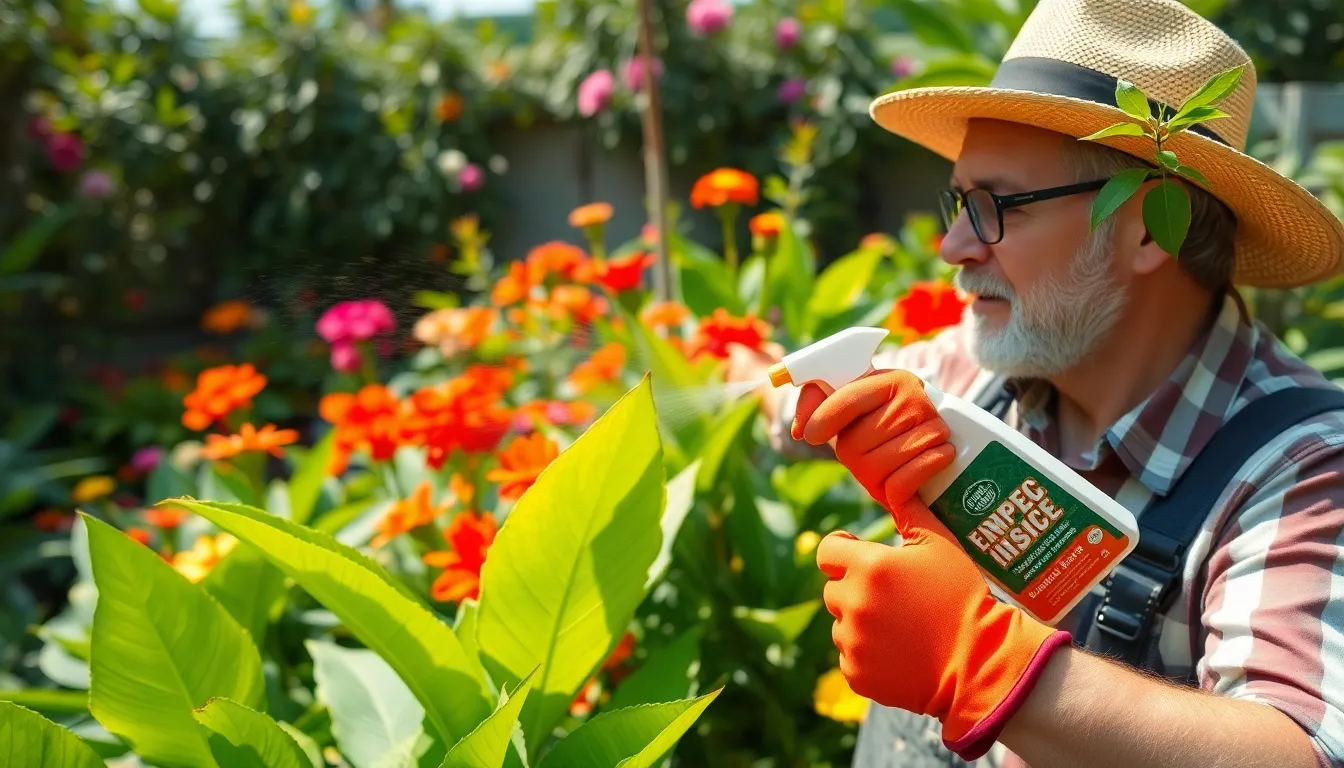
When natural methods aren’t providing sufficient control, commercial insecticides offer powerful answers for persistent aphid problems. We’ll explore targeted chemical treatments that deliver reliable results while maintaining garden safety.
Choose Systemic Insecticides for Severe Cases
Systemic insecticides containing imidacloprid or dinotefuran provide comprehensive aphid control for heavily infested plants. These products work by distributing chemicals throughout the plant’s vascular system, eliminating aphids that feed on any part of the treated plant. We can apply them as foliar sprays for quick absorption or as root drenches for reduced pollinator exposure.
Root application offers the safest method for protecting beneficial insects since the chemical remains within the plant tissue rather than coating flower surfaces. The systemic approach takes several days to distribute fully throughout the plant, so patience is essential for optimal results. We should expect continued aphid activity for 3 to 5 days after application while the insecticide spreads through the plant’s system.
Use Contact Sprays for Immediate Results
Contact insecticides deliver instant aphid reduction by suffocating pests on direct contact. Insecticidal soaps and horticultural oils coat aphids effectively, disrupting their breathing and causing immediate death. We must ensure thorough coverage of all plant surfaces, particularly the undersides of leaves where aphids cluster most densely.
These treatments provide no residual protection, requiring repeated applications every 5 to 7 days during active infestations. Evening applications protect beneficial insects while maximizing contact with aphid colonies that remain active during cooler temperatures. We can also create effective homemade contact sprays using dish soap mixed with water or essential oils like peppermint, clove, rosemary, and thyme for safer organic control.
Follow Label Instructions for Safe Application
Product labels contain critical information for safe and effective insecticide use that we must follow precisely. Proper dosage prevents plant damage while ensuring adequate pest control, and timing restrictions protect both beneficial insects and human health. We should always apply treatments during late afternoon or evening hours to minimize pollinator exposure.
Reading harvest timing guidelines becomes especially important for edible plants, as many insecticides require exact waiting periods before safe consumption. Protective equipment recommendations on labels help prevent skin and respiratory irritation during application. We must also check for compatibility with other garden treatments and avoid mixing different chemical products unless specifically approved on the label instructions.
Prevent Future Aphid Problems Through Garden Maintenance
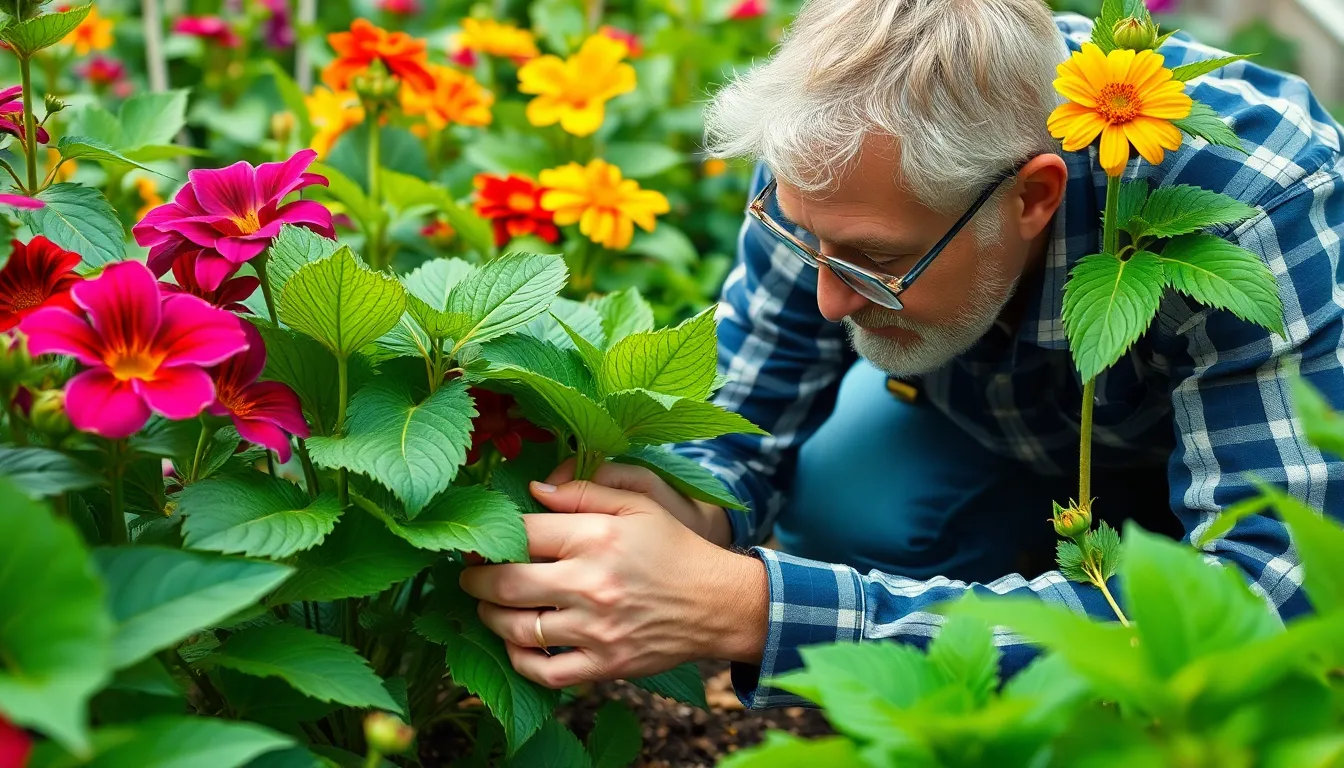
Once we’ve eliminated existing aphids, implementing proactive garden maintenance practices becomes essential for preventing future infestations.
Monitor Plants Regularly for Early Detection
Regular monitoring lets us catch aphid problems before they spiral out of control. We should inspect our plants at least twice weekly, focusing on new growth areas where aphids prefer to establish colonies. Check the undersides of leaves thoroughly since aphids often gather in these protected spots during their initial invasion.
Morning inspections work best when aphids are most active and visible. Look for the telltale signs we’ve already covered: clusters of small insects, sticky honeydew deposits, and yellowing or curling leaves. Document any findings with photos to track problem areas and identify patterns in our garden’s aphid activity.
Early intervention saves us time and prevents extensive damage to our plants. When we spot just a few aphids, we can remove them immediately by hand or with a quick water spray rather than dealing with full-scale infestations later.
Maintain Proper Plant Spacing and Air Circulation
Proper plant spacing creates an environment that naturally discourages aphid establishment. Crowded plants trap moisture and reduce airflow, creating the humid conditions aphids thrive in. We should follow recommended spacing guidelines for each plant variety to ensure adequate air circulation.
Strategic pruning improves airflow around existing plants without requiring replanting. Remove excess foliage and dead branches that block air movement through our garden beds. This practice also eliminates potential hiding spots where aphids can establish undetected colonies.
Wind movement disrupts aphid flight patterns and makes it harder for them to land on our plants. Position taller plants on the windward side of garden beds to create natural barriers that deflect these weak-flying insects away from more vulnerable crops.
Avoid Over-Fertilizing with Nitrogen
Excessive nitrogen fertilization creates the lush, tender growth that aphids find irresistible. High-nitrogen conditions produce soft new shoots with elevated amino acid levels, essentially creating an aphid buffet in our gardens. We should use balanced fertilizers instead of high-nitrogen formulations.
Soil testing helps us determine actual nutrient needs rather than guessing at fertilizer requirements. Test our soil every 2-3 years to understand its current nitrogen levels and apply only what our plants actually need for healthy growth.
Organic matter additions provide steady nutrient release without the nitrogen spikes that attract aphids. Compost, aged manure, and other organic amendments feed our plants gradually while improving soil structure and supporting beneficial microorganisms that compete with pests.
Conclusion
We’ve equipped you with a comprehensive arsenal of strategies to eliminate aphids and protect your garden. From simple water sprays and soap answers to beneficial insects and companion planting these methods offer sustainable alternatives to harsh chemicals.
Remember that consistency is key when dealing with aphid infestations. Regular monitoring combined with early intervention will save you time and effort in the long run. Whether you choose natural predators or targeted treatments the goal remains the same: creating a healthy balanced network in your garden.
Start with the gentlest methods first and escalate only when necessary. Your plants will thank you for taking a thoughtful approach to pest management that prioritizes both effectiveness and environmental responsibility.
Frequently Asked Questions
What are the early signs of aphid infestation in my garden?
Look for small, soft-bodied insects clustered on new growth and undersides of leaves. Common signs include visible aphid colonies (green, black, or brown), sticky honeydew substance on plants, yellowing or curling leaves, stunted plant growth, and the presence of ants protecting aphid colonies. Early detection is crucial for effective treatment.
How can I remove aphids naturally without using chemicals?
Use a strong stream of water from your garden hose to physically dislodge aphids, focusing on leaf undersides. Create a soapy water solution with mild dish soap and spray during cooler parts of the day. For small infestations, manually remove aphids by hand or wipe plants with a damp cloth.
What is the best homemade insecticidal soap recipe for aphids?
Mix a few drops of mild dish soap with water in a spray bottle. For organic gardening, use liquid castile soap mixed with water. Enhance effectiveness by adding essential oils like neem oil, garlic extract, or onion extracts. Apply every 3-7 days for best results.
Which beneficial insects help control aphid populations naturally?
Ladybugs are excellent aphid predators, consuming large numbers as both larvae and adults. Lacewing larvae also feed on aphids effectively. Attract these beneficial insects by planting flowering plants that provide nectar and pollen. Create habitats with water sources and native plants to encourage natural predators.
How do I properly apply neem oil for aphid control?
Dilute neem oil with water and mild soap according to package instructions. Apply during early morning or late evening to protect beneficial insects and prevent leaf damage. Spray every 3-7 days to disrupt the aphid life cycle. Monitor for new activity to determine when treatments can stop.
What companion plants naturally repel aphids?
Plant catnip and garlic around susceptible plants, as their scents repel aphids. Marigolds produce compounds that interfere with aphid nervous systems while attracting beneficial insects. Chives create natural repellent zones with their sulfur compounds. These plants can also be harvested for homemade organic sprays.
When should I consider using commercial insecticides for aphids?
Use commercial insecticides when natural methods fail to control persistent infestations. Systemic insecticides like imidacloprid provide comprehensive control through the plant’s vascular system. Contact sprays offer immediate results. Always follow label instructions for safe application and minimize impact on beneficial insects.
How can I prevent future aphid infestations in my garden?
Monitor plants regularly, especially new growth areas, for early detection. Maintain proper plant spacing and air circulation to create unfavorable conditions for aphids. Avoid over-fertilizing with nitrogen, which creates lush growth that attracts aphids. Use balanced fertilizers and conduct soil testing to meet actual nutrient needs.

